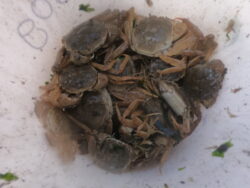Eco Marine carries out ecological surveys in a range of marine environments, therefore it is important that our staff are up to date on the invasive non-native species (INNS) present in UK waters and the legislation and control measures associated with them.
An area we have surveyed recently is the Thames Estuary, which has seen the settlement of a variety invasive non-native species over the years. From 1800 to 2010 a total of 96 non-indigenous freshwater species were identified within the Thames, equating to an average of 0.43 species invasions per year (Jackson & Grey, 2012). It is important to note however that not all non-native species cause harm to their surrounding ecosystems. Some of the most prominent invasive species that can be found in the Thames include the zebra mussel (Dreissena polymorpha), the quagga mussel (Dreissena rostriformis bugensis) and the Chinese mitten crab (Eriocheir sinensis).
The Chinese mitten crab (Eriocheir sinensis) is an invasive species present in the UK, which is native to Southeast Asia. The first record of the species in the UK was in 1935 in the river Thames, and were well established by the 1990’s. The crustacean has also been recorded in other rivers in the UK, including the Humber, Medway, Tamar, Tyne Wharfe and Ouse. In addition to inhabiting freshwater, they can also survive in brackish water, estuaries, and marine inshore coastal environments, which is likely one of the many reasons why they are so successful as an invasive species.
Adult mitten crabs have a grey-green to dark brown square shaped carapace with dense brown ‘fur’ on their white-tipped claws. This unique characteristic explains the scientific name Eriocheir sinensis, which is derived from the Greek meaning wool hand of the Chinese. Adults by far outgrow the common shore crab, Carcinus maenas, and can span 25cm in width.
The species have shown to detrimentally impact marine and freshwater communities by increasing predation rates and by competing with native species for space and prey, such as invertebrates and fish eggs. The species are also known to carry diseases which have the potential to adversely affect other crustacean species. Chinese mitten crabs can also cause damage to habitats. They burrow into riverbanks which reduces sediment stability, increasing the likelihood of erosion, river turbidity and possibly leading to banks collapsing and increasing the risk of flooding. Burrowing can also lead to the siltation of gravel beds, including those used for fish spawning. All of these impacts are part of the reason why the species is included on the IUCN 100 of the world’s worst alien species list.
The Chinese mitten crab is included in the Wildlife and Countryside Act 1981, listed under Schedule 9 and 14, which states that it is an offence to release or allow the species to escape into the wild. To help track and monitor the distribution of this species in the UK, sightings can be submitted online via the Mitten Crab Recording Project (https://www.mittencrabs.org.uk/) and the Marine Biological Association https://risc.brc.ac.uk/mitten_crab.php.
